This is the final installment of my mini-series on self-editing for authors. In the previous five posts, I’ve covered the way I think about the various stages of editing my own work. Of course it’s not that tidy; writing and editing are iterative efforts, and in the age of digital writing those iterations are often pretty fluid. It would be interesting to know what percentage of my sentences are typed without any use of the delete key as a change my mind about the words I want to use. I’m guessing it would be pretty small.
In this post, though, I want to talk about how to edit for the details. Once the right content is in place and the structure of the piece is right, and after the word choices and stylistic flair feel right, in theory, you have a draft that is ready for the detailed edit. For me, because I’m typically doing this on screen, this is a blend of copyediting and proofreading. The point is error-free prose, and error-free presentation. It’s looking for misspellings and typos, grammatical issues and punctuation problems. Here are a few tips that have helped me.
- Read aloud. I wrote about reading out loud for the style edit, to engage a different mental process. In that case, it’s about the benefits of listening. In this step, it’s about the actual reading. We read faster than we can speak. Reading out loud makes the stumbling blocks very obvious.
- Don’t rely on automated checkers. Spellcheck is a great tool, but it’s imperfect, and the gap gets wider as your writing gets more complex and nuanced. Sometimes spellcheckers flag things that are correct, and miss things that are wrong. And many times, there are stylistic choices that automated grammar checkers just can’t evaluate correctly.
- Start from the end. This is especially useful for proofreading shorter pieces, or for chunks of a longer piece. Reading backwards short-circuits the mind’s ability to fill in the blank. I usually don’t do this literally from the last word, but I start from the last sentence of a paragraph.
- Search again. I like using search in the style edit for word choices, but in the mechanical edit it’s great for things like formatting em dashes according to the chosen style guide, being consistent about punctuation or spelling choices, and font and layout issues. I’ll often use the find-and-replace feature for these things—I just don’t “change all.” I look at each instance and decide if I want to accept the change.
- Use paper. For me, there comes a point where I need to work from a hard copy. I’m not exactly sure why this works for me, but I will see things on paper that I completely missed on the screen. I suspect it has something to do with the different physical engagement. It’s the same reason that reading an ebook is different from reading a paperback.
To wrap up, I’ll just say that my way of looking at the self-editing process is just one writer’s approach. There are many fantastic resources online that offer deep dives into all these steps, and many people with great expertise who have developed courses, guides, checklists, and more. Sites geared to people who are learning the language can be tremendously helpful for finer points, and styleguides offer answers for many nitty-gritty questions. Plus there are a surprising number of people who know everything about grammar. There is also an abundance of conflicting opinions that at least can guide your thinking. I hope that something I’ve shared is useful and can help you strengthen your own writing.
Previous posts in this series:
- Part 1: The most important step when editing your own writing
- Part 2: The content edit: editing for coherence
- Part 3: The structural edit: following the thread
- Part 4: The style edit, part 1: the sound of style
- Part 5: The style edit, part 2: word search
Photo by energepic.com from Pexels


